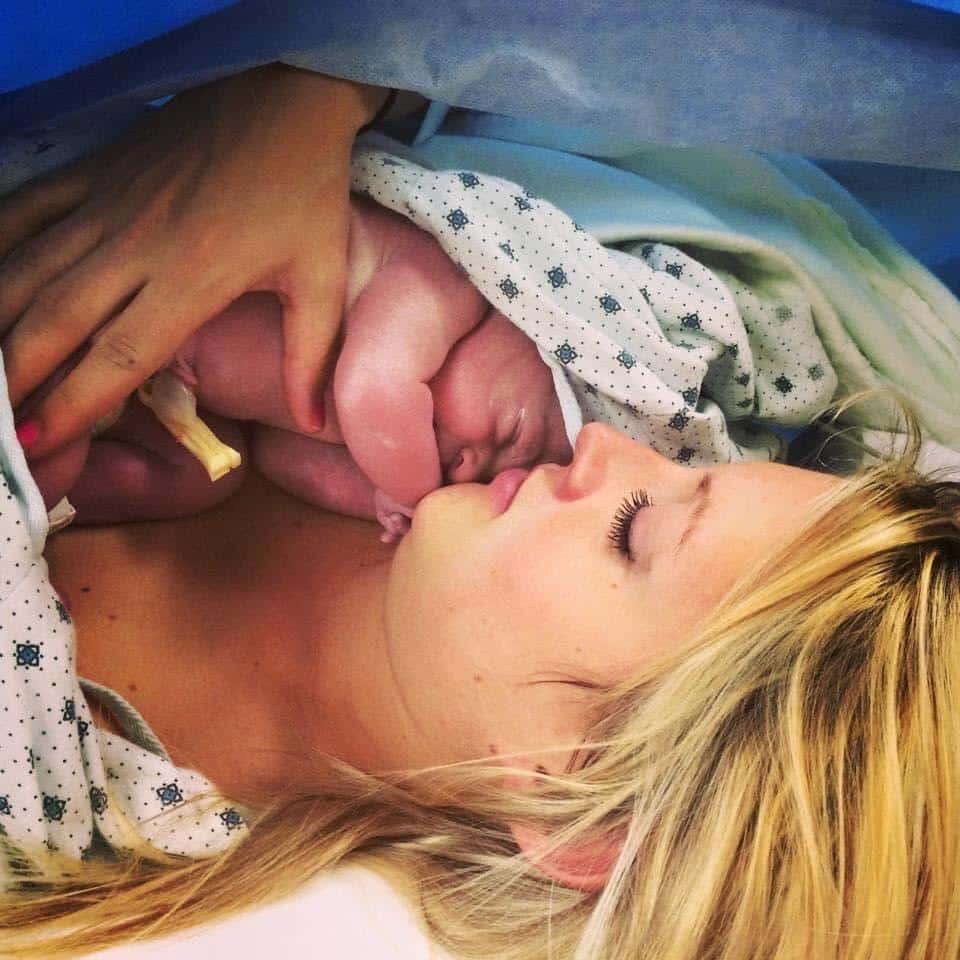Hearing the words natural and c-section together, a lot of people wonder, “Is a natural, gentle, family centered cesarean birth even possible?”
You envision a cesarean without medication, or without modern technology.
That is most definitely not what I mean.
A Family Centered Cesarean or Gentle C-section provides options during birth to offer some of the same experiences and benefits that happen with a vaginal birth.
As birth practices have evolved, so have c-sections. Parents may not be aware of all the options they have to influence what happens with a cesarean, and their new baby, in the operating room.
While there are some benefits of a natural birth, unplanned c-sections do happen. You can’t always make the choice you wanted between a VBAC vs repeat c-section, especially when things go wrong.
Even if you’re planning for a VBAC, sometimes there are reasons a c-section is necessary. Knowing what’s most important to you when you greet your new baby, a gentle c-section plan can help you keep some of those elements in place.
This article covers the choices you can make to have a family centered cesarean, and all the ways it can improve the birth experience, for you and your baby.
You’ll also learn how to make a simple and effective c-section birth plan to share with your team at the hospital.
Why have a Gentle C-Section?

There are benefits in having a family-centered cesarean for both the parent and the baby, whether it’s medically necessary or an elective C-section. Feeling in control of your birth choices can help avoid postpartum depression and encourage a deeper connection with your new baby.
I had a gentle cesarean with my second baby, and the experience was so much better than my previous, more traditional c-section. The biggest differences for me were:
- Feeling more involved with my birth.
- A deeper connection with my daughter, right from the moment I held her.
During my natural c-section, my provider spoke with me the entire time. This constant communication made me feel less out of control and more aware of what was happening to me.
I was able to listen to my music of choice, which helped me relax.
I was also able to hold my baby on my chest shortly after she was born, which not only helped us to quickly bond but also made the second half of the c-section more enjoyable.
Planning a Family Centered Cesarean

One of the hard things about planning a family centered cesarean is the fact that not all providers are doing them. Not all hospitals have the equipment or staff to support them.
We encourage you to have this discussion with your provider leading up to birth. Also don’t hesitate to call your local labor and delivery unit and ask them what they provide in the OR.
Ask your provider, “In the event of a cesarean section, what options do I have for delivery to make it more of a gentle approach?”
Here are some of the factors that can make a cesarean more gentle and family centered, that you may consider including in your c-section birth plan.
Clear drape at delivery
During a c-section, there is a blue drape placed in front of the parent(s) blocking the view, but keeping things sterile. When the baby is getting close to delivery, a clear sheet drape can be attached to this curtain.
This clear sheet allows the parents to see through the curtain so they are able to see as the provider holds up the baby.
NOTE: It is not gory at all. Because of the flat position the birthing person is in, the abdomen is low enough and the curtain covers a lot. It’s not likely you will see anything but the baby coming up.
Playing your own music during your birth
Playing your own music can truly set the mood and help you stay calm. Choose music that you tend to enjoy and that brings comfort.
When a person feels comfortable during their c-section, it can help emotionally and psychologically.
During my gentle c-section, I loved having music playing. It really helped me stay calm and drowned out the beeping and other noises in the background that were causing me some tension.
Letting the birthing parent assist in bringing the baby out
It is rare, but this has been done.
The provider can sterilize the parent’s arms and hands, and then completely pull down the drape. As the baby is about ready, they guide the parent’s hands to the baby and let them help bring the baby up.
Delayed cord clamping or milking the cord
Delayed cord clamping is a very popular request, and quite frankly, is becoming standard practice in birth.
Delayed cord clamping allows the cord to push the blood back up into the baby. According to ACOG (American College of Obstetricians and Gynecologists), delayed cord clamping has a great benefit to the baby. It provides an easier transition, better blood count volume, and can even avoid the need for a blood transfusion.
Based on how the baby is doing when they are born, the provider can choose to keep the newborn attached to the umbilical cord and allow the cord to pulse. The provider would hold the baby close by as they stay attached to their cord.
Once the cord is done pulsing, the provider will likely cut the cord, but you can also request for your birth partner to cut it. Although, in trying to maintain a sterilized area, they may not feel comfortable with anyone passing the drape.
If a provider states that it is unsafe to allow delayed cord clamping, due to the fact the parent is still in surgery, you can request the cord to be milked. Milking the cord is when the provider pinches the cord at the bottom and sends the blood to the baby quickly by stroking the cord.
Keeping the vernix on the baby
Vernix is a white sticky substance that coats the baby’s skin while they are in the uterus. Vernix plays many roles in the baby’s health, such as developing a healthy gut microbiome, protection, and an easier transition into the world.
It is very common for providers to immediately wipe and stimulate the baby when they are born. With doing so, they can remove the protective layer of vernix from the baby’s skin.
If this is something you would like, simply request for the staff to please leave all or as much as possible of the vernix on your newborn.
Immediate or quick skin to skin contact
This means right after the birth, your new baby is brought around and placed on your chest. Skin-to-skin contact starts the bonding process and allows you to be with the baby right away, as would normally happen after vaginal birth.
Otherwise, you may be separated from your baby for 45 to 60 minutes.
Normally during a c-section, staff would bring the baby over so you can see them for a moment, and then take them to a warmer to check vitals and perform a newborn assessment. During this time, your surgery will be finishing.
It typically takes 45+ minutes to finish the last part of the surgery. Once you are done, they would reunite you with your baby.
According to Evidence Based Birth, 75% of babies are separated from their parents in the first hour. This is a major delay in the skin-to-skin bonding period. If you are unable to do skin-to-skin contact, you can have your birth partner do it until you are able to.
Intraperitoneal repair vs exteriorizing the uterus
Exteriorizing is when the uterus is removed from the abdominal cavity to be sutured after a baby is delivered by c-section. The alternative method is intraperitoneal repair. The uterus is sutured within the abdominal cavity vs. being taken outside of the body.
Studies have shown that for people who have intraperitoneal repair vs exteriorizing, the chances of nausea and vomiting are lower during the postpartum recovery period.
Vaginal seeding
During vaginal birth, the baby receives important microbiota as they pass through the vagina. With a cesarean, babies can miss this opportunity to seed their microbiome and help develop their immune system. Studies are showing that this process may even decrease the chances of the child having asthma.
The vagina can be swabbed before delivery, to provide a source of seeding to the baby. The swab is placed in a sterile baggy or cup.
The swab is later placed in the baby’s mouth and nose to help provide the vaginal microbiome that they were unable to get due to passing through the abdomen.
Breastfeeding in the operating room
When skin to skin contact is done, it also can be beneficial to have the baby try to nurse. This can sometimes be tricky in the OR, but it’s possible with some assistance.
One of the best ways to do this is to request a belly band from the hospital staff, and tuck the baby inside. This is fantastic for maintaining skin to skin contact, even if nursing is too hard at the time or not desired.
Ask the birth partner to help get in a good position. Don’t get too worried if the baby doesn’t latch right away while laying flat. It is a harder position to nurse in, but some babies catch right on.
Taking photos in the OR
Just because you are in a sterile environment, that does not mean you should not be able to document your birth. Discuss with your provider beforehand, and let them know that you plan to record.
Some hospitals have rules against video recording due to liability. They prefer not to have a recording of the procedure being done. However, most operating rooms do allow photos.
Some parents believe that if a provider is confident in what they are doing, they should not mind a video being filmed. But it is still a good idea to discuss with your provider.
Support people in the operating room
This is a huge one! Having more than one support person in the OR with you can be extremely beneficial. This extra person can be a trained doula, or a supportive friend or family member.
Having a family centered cesarean most definitely will lessen the chances of you being left alone while the staff cares for the baby. However, if there is any reason the baby is unable to come straight to the parents having an extra support person to be by your side is comforting.
Your support people can communicate to help you know what is going on with the baby, help if you are vomiting, or even just stroke your hair and provide comfort.
An extra support person can also take photos and help document the moments you are unable to see.
Gentle cesarean birth plans

We have talked about VBAC birth plans, but what about cesarean birth plans?
For my own doula clients, I suggest not including your cesarean birth plan attached to a VBAC birth plan. This will keep you and your birth team focussed on the vaginal birth you would like to have.
However, I do suggest having a backup cesarean birth plan tucked away, in case it is needed.
As with a VBAC birth plan, the most important things to list in your family centered cesarean plan are the factors that matter most to you. I encourage you to educate yourself and consider what is most important to you.
This article has listed the common choices most people make in preparing for a family-centered Cesarean. Decide what’s key for you and your experience, and ask in a kind way for hospital staff to work with you as much as they can.
Not sure how to have a successful VBAC or Cesarean?
We have created a family centered cesarean birth plan template for you. Please feel free to use this to create your own custom version. Sign up below to download your free copy.
Choosing cesarean

Last but not least, we would like to point out that although we have courses on VBAC for both parents and birth workers, we also recognize that c-sections are sometimes needed and even desired.
We often see birthing parents on our VBAC Facebook Community say things like, “I just want to know what it feels like to give birth.”
It’s important to recognize that all types of births count as birth.
We want to remind you that whether it is vaginal, c-section, unmedicated, medicated, or even assisted with vacuum or forceps, you are still giving birth.
You should be proud of yourself for growing a human and giving them life.
Cesarean sections do not have to be scary or traumatic births. It is very possible to have a beautiful experience with a planned and even an unplanned c-section.
With my second c-section, it was not what I desired, but it was such a healing experience for me and one I will cherish forever. There are many stories like this, and you can listen to Lindsay’s on The VBAC Link Podcast. She talks about her unexpected family centered cesarean when her baby went breech.
Choosing a cesarean when not desired can be hard, but sometimes there is a medical need. We encourage you to follow your pregnancy intuition and do your homework. Educate yourself the best you can and be confident in your decision.














 How to Turn a Breech Baby: 8 Ways to Flip That Baby
How to Turn a Breech Baby: 8 Ways to Flip That Baby
Thanks for sharing this wonderful idea its really help me a lot keep posting such amazing ideas